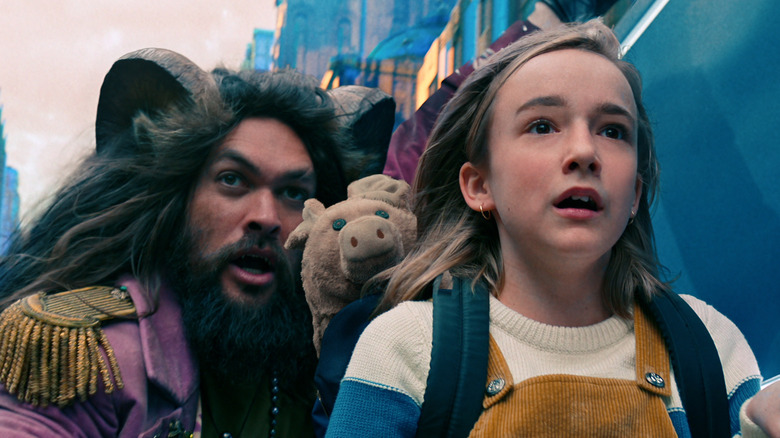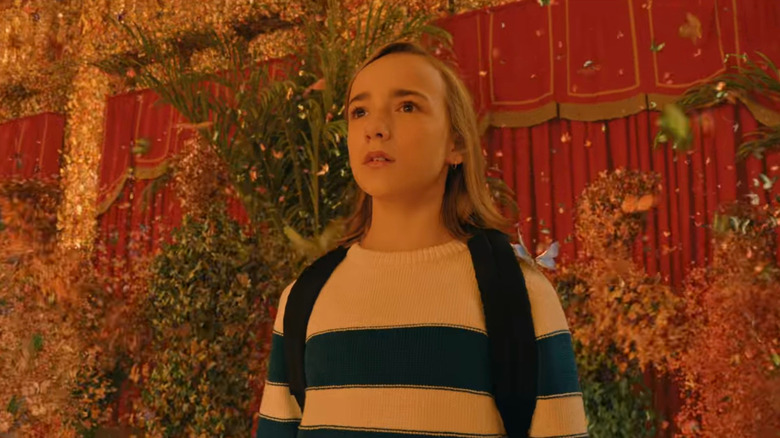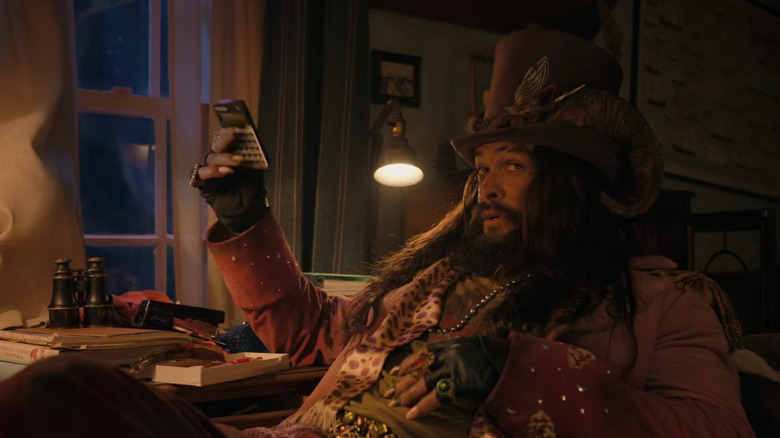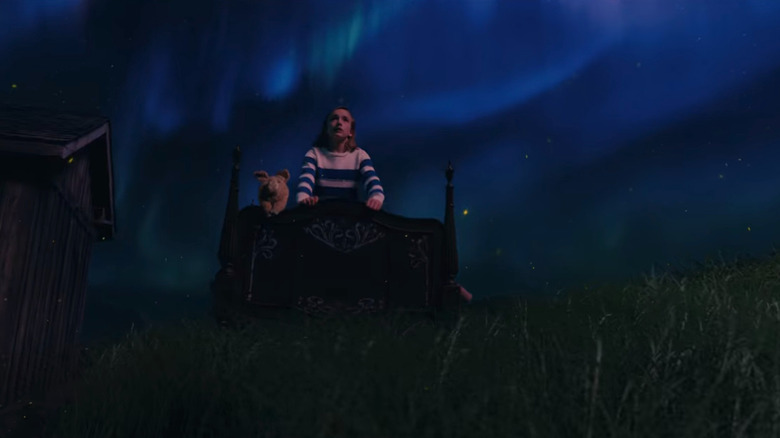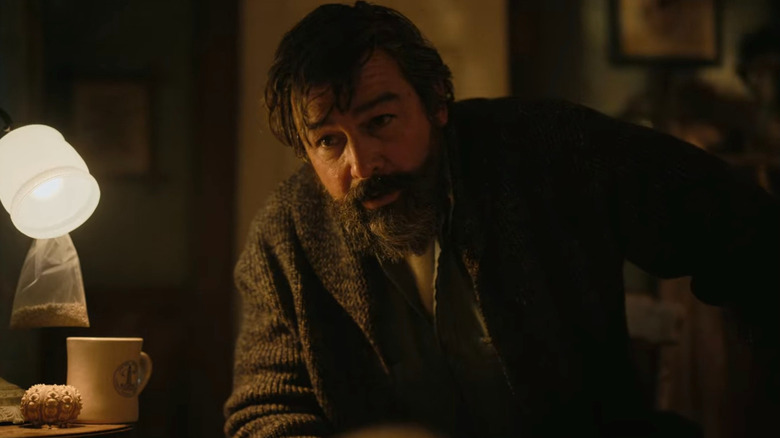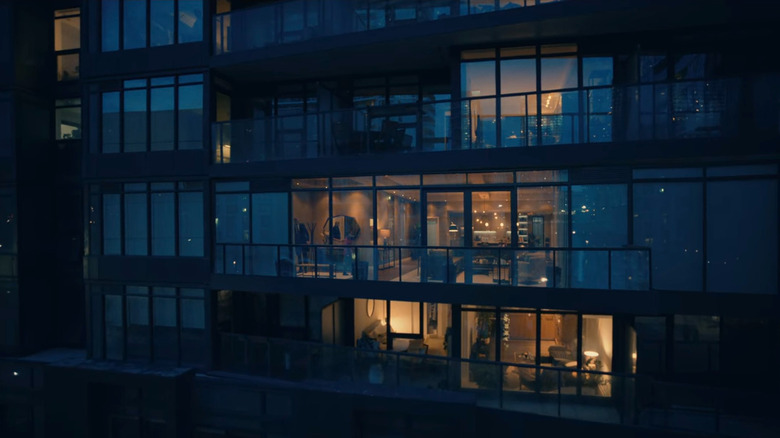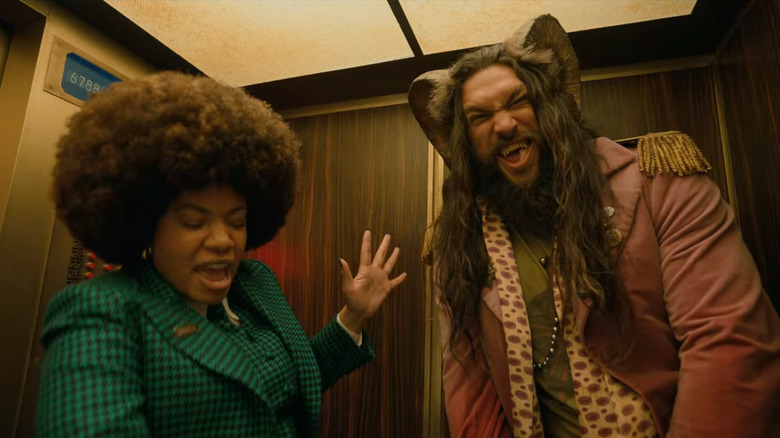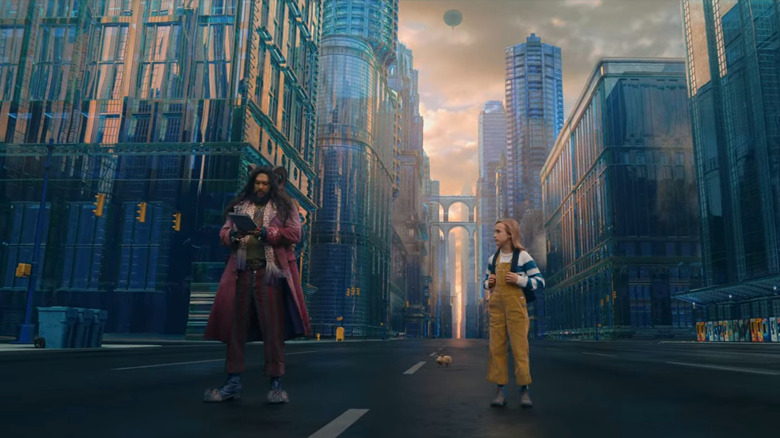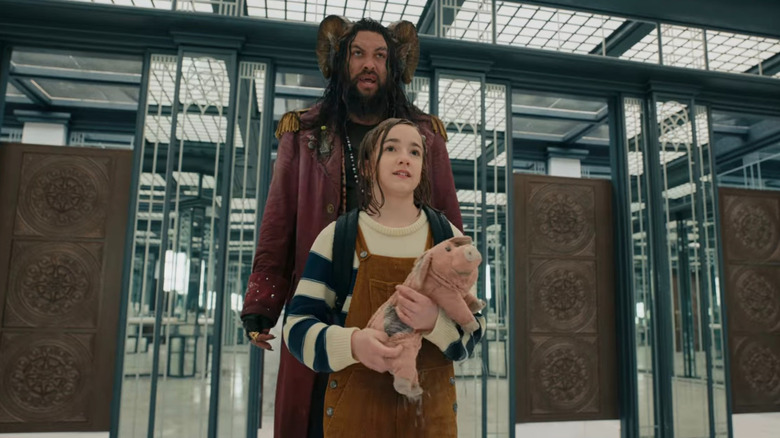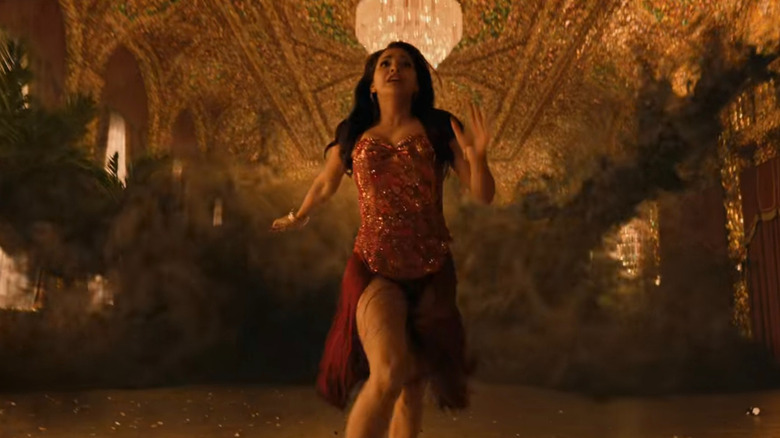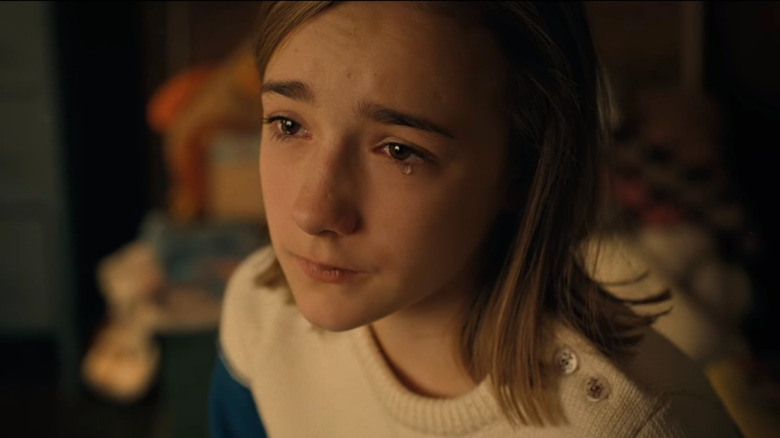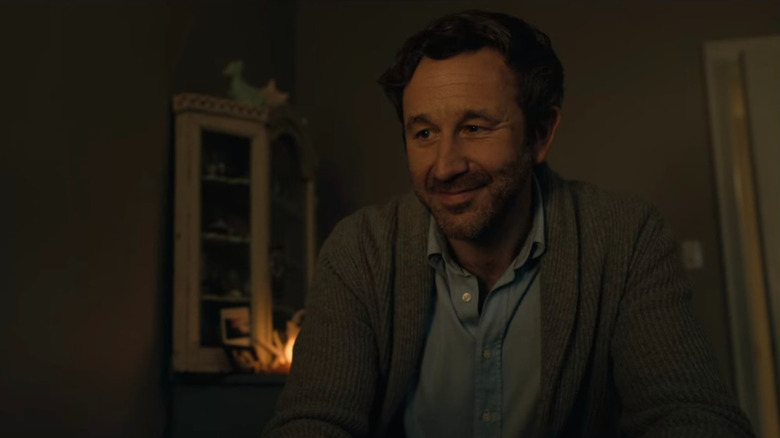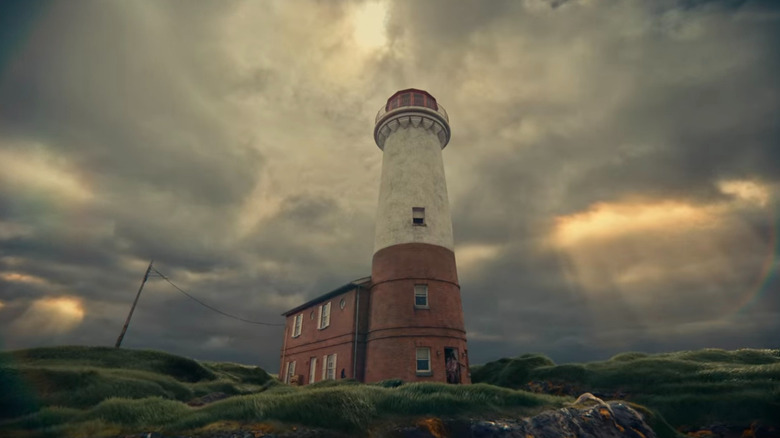Slumberland: The 6 Best And 6 Worst Things About Netflix's Fantasy Adventure
Francis Lawrence is probably best known as the director of most of the "Hunger Games" franchise. But between journeys to Panem, he's also helmed films like the spy thriller "Red Sparrow," based on the novel of the same name by Jason Matthews, and the Netflix fantasy film "Slumberland."
The second film based on the "Little Nemo" comics by Winsor McCay (after 1989's "Little Nemo: Adventures in Slumberland"), "Slumberland" follows a girl named Nemo (Marlow Barkley) who meets her father's old partner Flip (Jason Momoa) in a dream after her dad dies. Flip and Nemo's father Peter (Kyle Chandler) used to be outlaw treasure seekers together in the dream world of Slumberland. They were after wish-granting pearls that could only be found in the depths of the "Sea of Nightmares," but they never found them. So when Flip meets Nemo, he begrudgingly enlists her help (and the help of the treasure map she holds) in a hunt for the pearls.
The movie shows off Lawrence's talent for large-scale adventure and stunning visual effects, and it includes some emotionally impactful performances. However, it also falls prey to a number of issues that hold it back from becoming a modern fantasy classic. In the interest of exploring what really works and what sadly doesn't in "Slumberland," let's take a look at some of the best and worst things about the film.
Warning: There will be spoilers for "Slumberland" ahead.
Best: A bright and colorful world
From the first scenes when we see Nemo and Peter on their lighthouse island, "Slumberland" offers images of a beautifully bright and colorful world. The waking world sunrises on the island are full of glowing greens and reds and surrounded by the bright blue sea and sky. And when Nemo and Flip make their way through different dream realms, "Slumberland" continues to be full of excitingly colorful images.
It's especially fun to see a movie this bright and colorful at a time when movies and TV are becoming increasingly dark. The visuals immediately make "Slumberland" something special — a film that's willing to buck the trend toward darkness to allow viewers to really bask in the glory of these beautiful colors.
Those vivid hues and the film's often glowing quality aren't just visual treats, though. Throughout the movie, the brightness is contrasted with darker images for thematic reasons, whether it be fear entering a dream space or the loss of hope in the waking world. This back-and-forth between the light and dark makes the vibrant moments pop even more.
Worst: Flip's introduction
It makes a lot of sense that Flip, who is a goat horn and ear-sporting humanoid in this adaptation of "Slumberland," was originally a clown in the comics. The character is a bit of a bumbling fool who fancies himself a smooth criminal and legendary "outlaw." He also often jokes in a way that fluctuates between light-chuckle-inducing and simply annoying. Sadly, all of these negative qualities really hit hard when the character is first introduced.
Nemo falls asleep and dreams of her home at the lighthouse, and she meets Flip as he's rummaging through her father's things looking for the map of Slumberland. At first, they both scare each other, but then Flip begins to condescendingly explain things to Nemo and tells her that she needs to find him the map so that he can continue his hunt for the wish-granting pearls.
Flip grows up over the course of the movie and becomes less of a jokester, or at least, he isn't able to make as many quips in the middle of daring adventures. That helps the character become more likable as the story goes on, but his introduction is rough. It's a moment that might make some viewers nervous about continuing the movie, but luckily, it's really just his introduction that shows his worst side.
Best: The score
While "Slumberland" may not become a fantasy classic, composer Pinar Toprok's score is on the level of some of the best adventure film music ever made. The score uses a full orchestra to bring a sound to the film that evokes Howard Shore's work on the "Lord of the Rings" movies and John Williams' iconic music for "Star Wars."
The score in "Slumberland" is rousing during the most thrilling adventure moments and lends real pathos to Nemo's downbeat emotional scenes. It's a soundtrack that seems to simultaneously draw on the great adventure movie scores that have come before and make a case for continuing to create full orchestral scores going forward. The soundtrack also plays the perfect trick of adding to the film while not distracting from it. It adds power to the scenes where it's used, but it never draws attention from what's happening by being too complicated or catchy on its own. It's a great piece of film music that makes us excited to keep listening to Toprok's work in the future.
Worst: Awkward exposition dumps
Like any fantasy movie that introduces the audience to a new world, "Slumberland" has to include a lot of exposition. Sadly, the movie doesn't always do this so smoothly.
At the start of the film, Peter tells Nemo a bedtime story about his and Flip's adventures — how they searched for the wish-granting pearls and braved the Sea of Nightmares, but to no avail. It's a great way to introduce some of the world that the audience will see later in the movie when Nemo enters Slumberland. This exposition dialogue is elegantly integrated into the story of the film and works as an effective emotional beat to show us how close Nemo and Peter are. The problem is, almost every subsequent piece of exposition in the movie feels much more awkward.
From Flip explaining that there is a Bureau of Subconscious Activities (AKA "BoSA") to his description of how dying in dreams works, the movie includes a lot of scenes where Flip simply explains things to Nemo. These expository moments slow down the action of the movie significantly, sometimes stopping it altogether. This is especially clear during one chase scene where the action pauses for a bit so that Flip can explain that nightmares only attack the person who's scared in a dream. These moments do their job of introducing new concepts to the viewer, but they're awkward and slow the momentum of the adventure.
Best: Powerful production design
It makes sense that a movie with multiple dream sequences, each of which creates a brand new magical world, has a great production design. Every dream needs to feel both real and dreamlike while we're there, and "Slumberland" manages to pull that off fantastically. From the dazzling red and yellow of the first dream Nemo and Flip enter to the stunning snow-capped vistas of the dream where they ride a goose, every dream world is equally believable and perfectly otherworldly. And of course, the perfectly 1970s BoSA offices are a throwback delight, even if they aren't exactly otherworldly.
What makes the production design really stand out in "Slumberland" though is the way the waking world spaces are contrasted — not only with the dream worlds, but also with each other. At the start of the movie, we meet Nemo and Peter on their cozy and colorful lighthouse island. But when Nemo moves in with her uncle Phillip (Chris O'Dowd) in the city and starts going to school, these spaces are built almost entirely of cold glass, steel, and white or gray concrete. These visual choices make a real emotional and thematic impact on the movie about the different spaces and how they make Nemo feel. One is full of life, while the other is harsh and unwelcoming.
Worst: The humor
Knowing that Flip was a clown in the original "Little Nemo" comics makes some of his jokes make more sense, but it doesn't make them much funnier. Luckily, Flip slows down on joking around as much, or at least on being as over-the-top silly as the film goes on. Still, "Slumberland" has a lot of other attempts at humor that just don't quite land.
"Slumberland" is a fantasy adventure movie that's also a kids' movie, so it makes sense that a good amount of the humor is going to be silly. But sadly, a good amount of that humor ends up being more annoying than funny — especially when the same jokes keep getting repeated over and over again. These include the successive jokes about the Canadian dreamer who Nemo and Flip meet on their journey, which are mostly harmless but unfunny stereotypes about geese, Tim Hortons, and hockey.
Not all of the comedy is bad, but even the funniest moments are just enough to put a smile on your face, while the worst are actively disappointing.
Best: The dream sequences
It's a prerequisite that a movie about dreams offers the audience truly otherworldly images and locations. Whether we're talking about horror movies like "The Nightmare on Elm Street," inventive anime like "Paprika," or a crime thriller like "Inception," any movie about dreams has to include some show-stopping dream sequences to be considered a success, and "Slumberland" certainly delivers on that front.
In Nemo's first nightmare, she witnesses the death of her father at the tentacles of a giant squid made of dark smoke. In her first dream, she sees people made of butterflies. These sequences are all beautiful or exciting, and often both. Some are just downright fun to watch.
The best, of course, combine the beauty and the excitement, like the blue city of glass that can continually create new roads for the dreamer's truck to speed through, or the Canadian's goose-flying dream that offers a thrilling aerial trip amongst breathtaking mountains. "Slumberland" is first and foremost a story about impossible adventure, and it nails the visuals on these different dreamscapes.
Worst: The repetition of dreams
While the dreams that we see in "Slumberland" are all a joy to look at, it's undeniably disappointing that the movie doesn't offer the audience more dream worlds. Every time that Nemo falls asleep and reunites with Flip to continue their treasure-seeking adventure, they go through the same dreams: Nemo's lighthouse, the butterfly people dancehall, the glass city with a speeding truck, the Dapper Dreamer's bathroom, and the Canadian's goose flying.
This repetition allows for some jokes to build, but with the humor being mostly lackluster, that's not necessarily the best thing. It makes sense for the characters to build a sort of rapport with the dreamers, but it doesn't feel like that justifies the repetition when we could be seeing exciting new dreams every time Nemo falls asleep. If the dreamers became more meaningful characters who helped Nemo and Flip on their adventure, it might make more sense, but as it is it feels like the return to these dreams only holds us back from seeing more great dream sequences.
Best: The visual effects
The most creative dream sequences wouldn't be successful without the visual effects that make them believable, and luckily, "Slumberland" offers some of the most exciting visual effects we've seen in recent memory. We've already discussed the incredibly realized people made of fluttering butterflies, the glass city that can seemingly grow new buildings out of the ground, and the giant rideable geese in the dreams that Nemo and Flip travel through, but "Slumberland" offers more than just brilliant images of dreams.
The slow-motion gun that Agent Green (Weruche Opia) uses on Flip and Nemo when they attempt to escape from her creates some really fun moments in the film. The bodies of those shot with the gun are forced into super slow-motion, almost to the point of complete stillness, but their eyes are still able to move around normally, allowing them to track what the people around them are doing. And while most of the visual effects in "Slumberland" are used to create images that are colorful and lively, the effects used for the smokey nightmare squid are also great and lend the creature a real sense of danger.
Worst: Heavy-handed messaging
"Slumberland" is a movie about a child's grief after the death of her beloved father. She reacts to his death by literally retreating into a dream world where she embarks on an adventure that will allow her to see him again. Nemo's arc in the film isn't about reconnecting with her father, but rather about learning to let him go. She has to figure out how to move on with her life and engage with the waking world again, no matter how hard it may be to let go of her dad.
That's a pretty heavy narrative for a children's movie, but it's also a valuable one — not only in regards to grief, but in any context where the reality of the real world might make you want to retreat into fantasy. What's disappointing, though, is that "Slumberland" keeps harping on this message explicitly, making the whole thing feel pretty heavy-handed.
If it were explicitly stated once, that would make sense. This is a film for kids after all, so making sure that they understand the message is reasonable. But when that lesson is repeated by so many characters over and over again throughout the movie, it ends up diluting the power of the message instead of strengthening it. Plus, having characters directly state the themes of the movie over and over is just annoying.
Best: The emotion shines through
Despite the heavy-handedness of the messaging in "Slumberland," there are still some real and powerful moments of emotion in the film, especially towards the end. While the writing creates these moments, it also sometimes stands in the way of them because it's so on the nose. What makes these emotional beats really land is the performances from the leads.
Marlow Barkley is young, but she makes us believe every moment of Nemo's emotional journey through the film. From her devastating grief over the loss of her father to her determination in her adventure with Flip and ultimately her acceptance of the loss of her dad and the love of those who are still alive, Barkley's performance makes every moment not just believable, but palpable for the audience.
When the film reaches its conclusion, her performance (along with Momoa's and O'Dowd's) makes "Slumberland" an emotionally honest and impactful movie that hits viewers in the heart, even if the overbearing messaging misses their head.
Worst: The runtime
"Slumberland" is just under two hours. That's not especially long for a fantasy adventure movie, and it's certainly got nothing on the extended editions of the "Lord of the Rings" films, but it's also not necessary for this story. The runtime being a problem follows the repetition of dreams as one of the worst things about "Slumberland," as the repetition makes the movie end up feeling longer than it needs to be.
It's not just the repetition of dream sequences, though. There's also the issue of how the movie moves back and forth between Slumberland and the waking world, which creates a sense that the story is running in circles. And while the film ends up delivering a powerful emotional ending, the final adventure section drags a bit and feels like it doesn't need to take as long as it does.
This hurts the movie, not just because it's too long, but because it also lets the tension needed for a thrilling adventure story dissipate in the final stretch. If "Slumberland" were even 10 or 15 minutes shorter and cut some time off the scenes in the waking world that aren't as exciting as the Slumberland adventure sequences, it would be a much more streamlined and stirring adventure.
